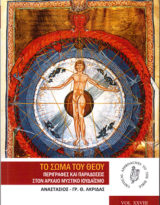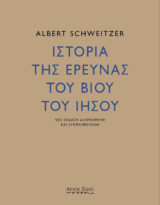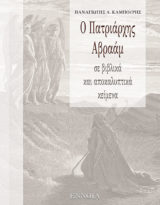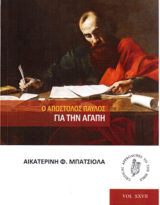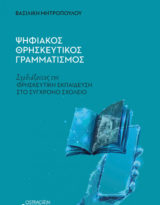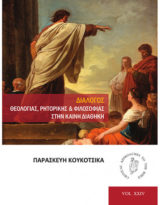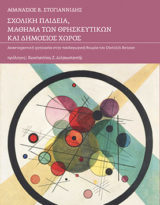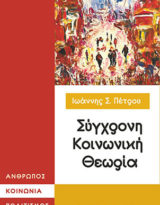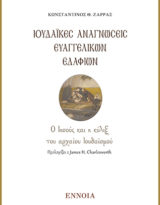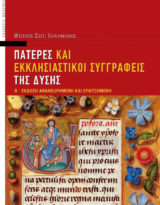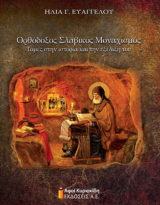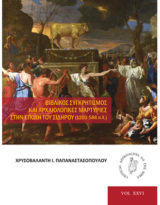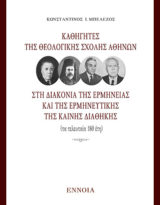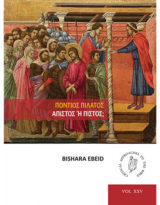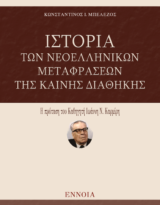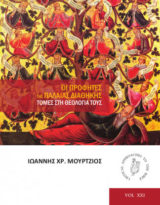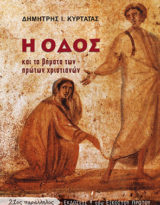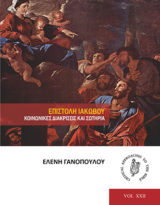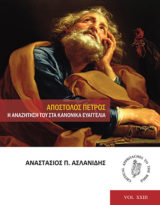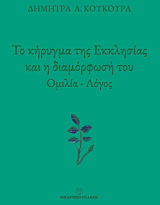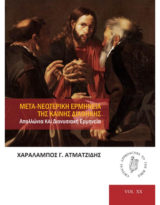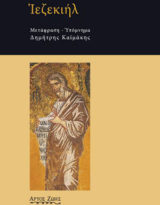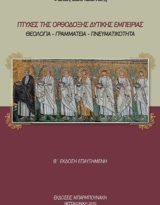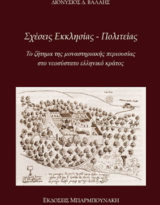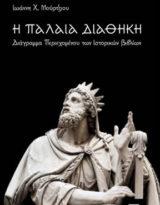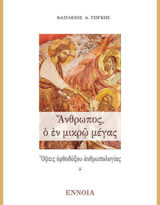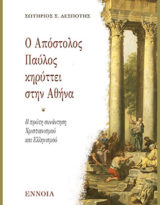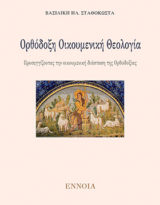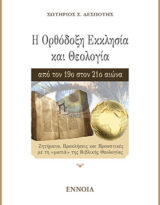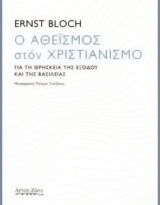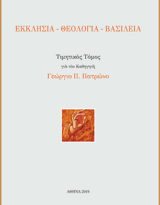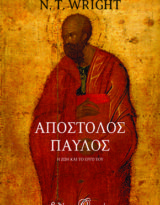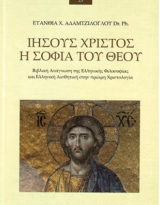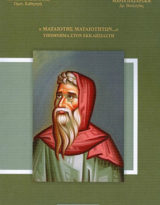Overcoming Capitalism-with Luther, Marx and the Ecumenical Movement
Δευτέρα 26 Φεβρουαρίου 2018, Αμφιθέατρο Α΄ της Θεολογικής Σχολής του ΑΠΘ
It is a great pleasure and honor to be with you this morning in the lecture time of Prof. Tsompanidis who is a good friend of mine since his studies in Heidelberg. I am mainly interested in discussion with you but Stylianos suggested I give a little introduction.
My theme is “Overcoming Capitalism-with Luther, Marx and the Ecumenical Movement”. My background for dealing with this topic is an international project between 2010 and 2017 by around 40 interdisciplinary scholars producing 7 volumes of studies, 94 Theses and the Wittenberg Declaration 2017. The theme of the project was “Radicalizing Reformation – Provoked by the Bible and Today’s Crises.” This title interconnects three historical contexts: antiquity, early modernity and today. The rationale for this was the following consideration. Luther claimed that all ecclesial traditions and contemporary church life had to be evaluated according to the criteria laid down in the Bible (sola scriptura). This also resonates with the principle “ad fontes” of humanism. In this way Luther regarded Scripture as the root (radix) of the church and theology. So we decided to test the Reformation using the criteria of the Bible as radix according to Luther’s own principle. This is why we called the project “Radicalizing Reformation”. This relates Reformation to biblical times and contexts.
However, Luther did not regard the Bible as the letter of the gospel, but as viva vox evangelii, as dynamically influencing personal and corporate life today. This means that hermeneutically we have to understand the interrelationship of three contexts: antiquity, early modernity and today. This approach led us to a very surprising discovery: Each of these contexts represents a specific phase of the development of money, influencing not only the economy but the whole of the respective civilization, including patterns of thinking and feeling. So capitalist civilization dominating every sphere of life today has deep roots in the history of money, which influenced each cultural stage.
Its prehistory begins with the emergence of money in everyday life in the 8th century BCE in the whole of Eurasia from China to Greece. In the West the climax of this first phase was the Roman Empire. Starting with the upper-Italian city states in the 11th century a new phase of money-driven civilization, called early capitalism, emerged, coming to the next climax at the time of the Reformation.
Whereas from the 11th to the end of the 15th century we are dealing only with commercial and usury capital, the subsequent phase is characterized by first manufacture and subsequently industry. Therefore it is called the phase of industrial capitalism reaching up to the third quarter of the 20th century. Its most famous analyst, Karl Marx, has his 200th birthday this year. Our present time is the phase of imperial financial capitalism.
Before we unfold this question we have to sharpen the profile of the problem facing us today. From day to day it is becoming more evident that the compulsory economic growth driven by the essence of capital, i.e. accumulation, is increasingly destroying life and the preconditions of life on earth. This means that we are not just living in a new phase of money-driven civilization but in the final phase. It has become not only death-producing but suicidal. For example, concerning the climate catastrophe, Richard Heinberg speaks of the time of the “Great Burning” and concludes: “Climate change is contributing to a mass extinction of species, extreme weather, and rising sea levels – which, taken together, could undermine the viability of civilization itself.”[1] Some scholars even talk about the self-burning of humanity.[2] These are facts in spite of a certain president’s narcissistic ignorance.
To avoid this catastrophe, humanity in the medium and long term is bound to develop a trans-capitalist, life-enabling and life-enhancing culture. So the whole history of the money-driven civilization in 2800 years has to be looked at if we want to link the Reformation with its roots, i.e. radicalize it, and ask what resources it contains to contribute to a life-enhancing culture in the midst of today’s life-endangering crisis.
Now I will briefly explain the different phases just mentioned and present the responses of the respective religions and philosophies, specifically of Martin Luther and Karl Marx, to these developments. Finally, I will present some suggestions concerning the present crisis.
- Structures and phases of the money-driven civilization starting in the 8th century BCE
Recent studies suggest that money did not enter daily use as a neutral means of exchange – it was in the context of emerging wage labor, especially in the form of mercenaries in the 8th century BCE.[3] Before this time – as of about 3000 BCE – money was only used as a unit of account and in long distance trade. With the professionalization of armies, mercenaries had to be paid. The first form of pay was the spoils (or booty), particularly precious metal, but then, people were paid in coins, after their introduction around 600 BCE.
The social consequences of the introduction of money into daily life were enormous. Free peasants, after having a bad harvest, could borrow seed only by paying interest and giving their land as pawn. When they could not pay back their loan they lost their land, their means of production, and the family had to work as debt slaves. We have a detailed description of this in the biblical book of Nehemiah, chapter 5. On the other hand, large-scale landed property emerged. One of the first historical witnesses of the new situation was the prophet Amos in the second part of the 8th century BCE (cf. e.g. Amos, 2:6-8).
Through the daily use of money with its new mechanisms of debt and slavery, not only the societies increasingly split into those impoverished and those enriched but also the mentality and attitudes of people underwent a deep transformation. With money, calculating thinking spreads.[4] Solidarity decreases. The money subject as such is the tyrant who assumes to be autonomous through the power of money – the great theme of the Greek tragedy.[5] Through economic activity by individuals, not as a community, insecurity enters the scene. The only security for participating in the market is having as much money as possible. This is the objective base for greed, the striving for unlimited accumulation of money. Greed becomes institutionalized in the form of interest.
It is also important to understand that, with the use of money, private property emerges beyond the personal ownership of useful things. Money gives property rights to the means of production. So money allows a more effective appropriation of surplus labor and surplus value. It also transforms slaves into impersonal commodities. Also patriarchy is re-enforced because only men are allowed to be property owners.
Finally, we have to realize that, from the beginning, the expansionism of money is linked to the expansionism of the empires through mercenaries.[6] Mines had to be conquered. They were staffed by war slaves to extract the metal to transform it into coins to pay the mercenaries. David Graeber calls this vicious cycle the “military-coinage-slavery-complex”.[7] The first climax of the emerging money civilizations can be seen in the Hellenistic empires and the Imperium Romanum.
All religions and many philosophies of that period rise in opposition to the emerging money-driven civilization – from Greece to China. In other words: This civilization is the historical and social context of these spiritual developments which the philosopher Karl Jaspers calls Axial Time.[8] The Torah and the prophets criticized the social consequences of money (like loss of land and slavery as the result of debt, made unpayable because of interest), called for justice and designed prohibitive and proactive rules. The Buddha identified greed as one of the poisons creating sufferings and tried to overcome it by teaching and meditative practices. For Aristotle the isolated greedy subject within the money-driven (chremastic) economy was a great danger for the polis. This is why he called for the prohibition of charging interest and building monopolies.
Jesus, in the context of the Roman Empire, says (Mt 6:24): “You cannot serve God and wealth (Mammon).” He links this to treasure building – at that time the form of money accumulation. With this statement he is not raising an individualistic ethical concern but calling for a decision between two antithetical civilizations – God’s just world (kingdom of God) guided by the Torah, on the one hand, and the Hellenistic-Roman civilization characterized by greed and violence, on the other. Some verses before (v. 19) Jesus had said: “Do not store up for yourselves treasures on earth.” So he is referring to the treasure-building phase of the money economy (not yet capitalist).
In the 7th century, Muhammad builds on this biblical base to confront the rich traders’ class in Mecca. His rejection of collecting treasures, charging interest on loans and his social engagement for justice and support for the poor is an influential example to this day. Theologically, the strong emphasis on the oneness of God is strongly linked to the oneness of and the solidarity within the human family. So I regard Islam as the third wave of the Axial Age.
When, in the beginning of the next phase of the money-driven civilization, Luther turned against early capitalism, he could do this very legitimately according to his method of evaluating every tradition and its present reality on the basis of the criteria of Scripture and reason. The Bible represents one of the religious and philosophical sources struggling with the emerging money civilization and its social and mental consequences. It is on this ground that he attacked the different developments in early capitalism. In his time the problems arose around commercial and usury capital – including its religious dimensions. Later Karl Marx continued the analysis in relation to industrial capital. In today’s worldwide oikoumene we face the climax of capitalist development: financial capital. Let us briefly look at these phases of critical-constructive thinking and acting.
- Luther’s theological, economic and political critique of early capitalist civilization as religion and of commercial and usury capital
Capitalism began in the Middle Ages and has continued in several phases until today.[9] Its elements became visible in the 11th century, particularly in the Upper Italian bank and trading cities Venice, Milan, Florence and Genoa. Venice promoted the Crusades (the first starting in 1095) in order to control the eastern trade route to India and China. The city also got rich by supplying the crusaders with arms and necessary equipment. So also the beginning of the second phase of the money-driven civilization shows the connection with military interests. However new in comparison to antiquity is that money accumulation does not end up in treasures but gets constantly reinvested for more profit. This new mentality is linked to new financial techniques like double-entry bookkeeping and compound interest. So money becomes capital and so creates a functional mechanism for constant and limitless accumulation as the single goal of economic activity. In terms of financial capital Florence becomes the leading power because they manage the finances of the Popes – the biggest capital of that time. Genoa at the end of the Middle Ages in 1492 links up with the hegemonic territorial and military power Spain thus participating in opening the phases of European colonialism and imperialism.
At the same time, theologian Anselm of Canterbury invents capitalism in heaven by formulating as the highest law: “Debts have to be paid back.”[10] This is why – he claims – God had to sacrifice his son, so that there is a divine fund from which human beings, entrapped in unpayable debt, can collect forgiveness by doing good works. Further, the church started profiting from the sins of money dealers by developing the doctrine of purgatory. It allowed people who had sinned – e. g. by charging interests on loans – to pay indulgences in order to avoid the punishments for their sins in purgatory. So money started to penetrate all dimensions of life – even religion, church and theology. Here lies the origin of the calculating God – the God who drove monk Martin Luther to despair.
At the same time movements emerged that challenged this assimilation of church and theology to the money culture by reference to Jesus, what were called paupers’ movements: Valdes, the founder of the Waldensian Church, Francis of Assisi, John Wicliffe and Jan Hus. Wicliffe also influenced the peasant movements (Lollards) in the late 14th century by standing up against the privatization of the commons (enclosures), one of the key factors shaping the emerging capitalism.
It was in this tradition that Luther began his Reformation. When, in his 95 Theses of 1517, he attacked the selling of indulgences, this had not only to do with a false piety. When he rejected the offering of salvation for sale and called for the overcoming of poverty instead he hit at the very heart of the new phase of a money-driven civilization. In thesis 28 he stated: “When a coin clinks in the money chest, profits and avarice greed may well be increased, but…”.[11]
This means that already in the 95 Theses Luther was attacking structure and mentality of early capitalism. This was about to subject all areas of life to the accumulation of capital. If it subjected religion and church, at that time the dominating forces, it would subject the whole of civilization. Money had become people’s god. Later Luther explained this in his interpretation of the first commandment in his Large Catechism. He calls Mammon:[12]
“Many a one thinks that he has God and everything in abundance when he has money and, possessions; he trusts in them and boasts of them with such firmness and assurance as to care for no one. Lo, such a man also has a god, Mammon by name, i. e., money and possessions, on which he sets all his heart, and which is also the most common idol on earth.”
“The most common idol on earth” – in our language this means: the whole civilization is oriented towards accumulation of money. In his time Jesus relates Mammon to “storing up … treasures“. For this period of the development Marx talks about “treasure building” (Schatzbildung). In the Middle Ages and modernity money accumulation became a functional mechanism[13], a money-vomiting “mega-machine”[14]. All profits were immediately reinvested for further accumulation. This meant that the whole political economy, and also the striving of each individual, was geared toward the accumulation of capital. The final loyalty was directed towards money. Money ruled as God. So Luther realized that capitalism is a religion. Later Karl Marx – many of his ancestors were rabbis – analyzed this reality with the category of fetish (idol). This fetish rules people and societies from behind their back in their relations to commodities, money and capital.[15] One key function of the fetish is to hide the fact that the surplus value is exploited labor. Walter Benjamin, the Jewish philosopher in the first half of the 20th century, speaks about “capitalism as religion”, the only religion which causes debts instead of writing off debt.[16]
That Luther, in his interpretation of the first commandment, did not only think of immoral individuals, but of early capitalism as a system, becomes evident when he explains the consequences of idolatry by interpreting the 7th commandment “Thou shalt not steal”:[17]
“…to steal is to signify not only to empty our neighbor’s coffer and pockets, but to be grasping in the market, in all stores, booths, wine- and beer- cellars, workshops, and, in short, wherever there is trading or taking and giving of money for merchandise or labor. … To sum up, this is the commonest craft and the largest guild on earth, and if we regard the world throughout all conditions of life, it is nothing else than a vast, wide stall, full of great thieves.”
At this point he speaks of the “arch-thieves”, meaning the transnational banking and trading societies like the Fuggers. The idolatry and the stealing of commercial capital can be seen first of all in the deregulation of prices:[18]
“First. Among themselves the merchants have a common rule which is their chief maxim and the basis of all their sharp practices, where they say: ‘I may sell my goods as dear as I can…What else does it mean but this: I care nothing about my neighbor; so long as I have my profit and satisfy my greed, of what concern is it to me if it injures my neighbor in ten ways at once?…How can there be anything good then in trade? How can it be without sin when such injustice is the chief maxim and rule of the whole business? On such a basis trade can be nothing but robbing and stealing the property of others.”
Again, it is important to see that Luther is not only criticizing a personal moral deficiency. The capitalists systematically rob the workers of the fruits of their labor which is the surplus value the workers have created.
This mechanism is even more evident when moving from commercial to usury capital. Here Luther adds a further element of analysis when he states that a usurer is not only a thief but a murderer. This means he realizes that capitalism is not just robbery but a murderous system. Luther says:[19]
„The heathens could conclude by reason that as usurer is a fourfold thief and murderer … For who siphons off, robs and steals the food of somebody does an as cruel murder as somebody who starves somebody to death or destroys him/her in other ways.”
This is exactly what Jean Ziegler, the UN Special Rapporteur on the Right to Food from 2000 to 2008, means when he states: “A child dying of hunger is actually murdered.”[20] He is referring to the fact that more than enough would be available if justly distributed. However, 20-40 million people die every year from the consequences of hunger (he speaks even of 60 million, figures that are difficult to document).
Luther adds yet another element of the analysis of usury showing that the usurer wants to play God over the indebted person. Karl Marx picks this up by saying:
“…in the usurer Luther very well demonstrates this imperiousness as an element of the drive to enrich oneself.”[21]
Luther draws three conclusions for action from his systemic critique?:
- He advises Christians and counsels merchants who want to be Christians on how to act. He challenges the church to be a contrast society and to preach with clarity about economic and political justice.
- He calls upon politicians to intervene in the market for the common good.
- He asks all people to reject the early capitalist system and its main protagonists as such.
Let us look at these points one by one.
- All Christians Luther advised to act according to the Sermon on the Mount: giving freely, lending without interest to people in need and even accepting the suffering of injustice while confessing publicly what is right. Some merchants had asked him how they could be good Christians and merchants at the same time. His response is revealing. For calculating the prices of their commodities he advises them to count their working hours and multiply them by the wage of a day laborer. This sum they should regard as their own income to decently finance the daily life of their family:[22]
“In determining how much profit you ought to take on your business and your labor, there is no better way to reckon it than by computing the amount of time and labor you have put into it, and comparing that with the effort of a day laborer who works at some other occupation and seeing how much he earns in a day. On that basis figure how many days you have spent in getting your wares and bringing them to your place of business, and how much labor and risk was involved; for a great amount of labor and time ought to have a correspondingly greater return.”
This text, especially recommended to CEOs and managers, has systemic significance. It means that the value of a commodity has to be calculated on the basis of the working time (necessary on average). For Luther, this means that the merchant must not extract surplus value as profit for himself from pure circulation (according to Marx’ categories Money-Commodity-(more) Money/M-C-M1). He rather must act in the form of pure exchange according to the scheme (Commodity-Money-(other) Commodity/C-M-C1/). In other words: the merchant should regard himself as a laborer like everybody else, not as somebody making (more) money out of money. As any worker he should feed his family by labor – not as a capitalist, siphoning off the surplus value created by the laborers.
Luther understands the community of the church as a contrasting society. The church is supposed to distance herself from the practices of the banks and trading companies, not only in words but in its institutional and financial behavior. The church must not charge interest on loans etc. It must take off the name “church” when it charges interest because it is supposed to give a good example to society and state. In his “Admonition to the pastors to preach against usury” (1543) he asks them not only to preach but use church discipline against people who make money out of money: exclude them from Holy Communion and, if they do not repent, refuse to bury them.
- As second measure against the exploitation through commercial capital Luther calls upon the governments to intervene in the markets. One of the measures is to regulate prices, as merchant capital operates according to the rule of raising prices as high as possible:[23]
“But in order not to leave the question entirely unanswered, the best and safest way would be to have the temporal authorities appoint in this matter wise and honest men to compute the costs of all sorts of wares and accordingly set prices which would enable the merchant to get along and provide for him an adequate living, as is being done at certain places with respect to wine, fish, bread, and the like. But we Germans have too many other things to do; we are too busy drinking and dancing to provide for rules and regulations of this sort..”
It could be said that the predominantly Lutheran countries in Scandinavia have shown how this approach bears fruit even under capitalist conditions. Because nowhere else – besides socialist countries – have governments intervened in the economy for the common good more than here. We even call it the Scandinavian model.
However, Luther is skeptical about the integrity of the governments under early capitalist conditions. This is even more evident when he moves from commercial to usury capital. Here he regards governments as already systemically corrupt:[24]
“How could it ever be right and according to God’s will that a man in such a short time should grow so rich that he could buy out kings and emperors? They have brought things to such a pass that everybody else has to do business at the risk of loss, winning this year and losing next year, while they themselves can always win, making up their losses by increased profits. It is no wonder that they quickly appropriate the wealth of the whole world, for a pfennig that is permanent and sure is better than a gulden that is temporary and uncertain. But these companies are always dealing with permanent and sure gulden for our temporary and uncertain pfennigs. Is it any wonder that they become kings and we beggars?
Kings and princes ought to look into this matter and forbid them by strict laws. But I hear that they have a finger in it themselves, and the saying of Isaiah [1:23] is fulfilled, “Your princes have become companions of thieves.” They hang thieves who have stolen a gulden or half a gulden, but do business with those who rob the whole world and steal more than all the rest, so that the proverb remains true, ‘Big thieves hang little thieves’.”
- This insight leads Luther at the end of his work on merchant capital to reject the system of capitalist corporations and business as such and to boycott its primary protagonists, the Transnational Corporations:
“On the trading companies I ought to say a good deal, but the whole subject is such a bottomless pit of avarice and wrongdoing that there is nothing in it that can be discussed with a good conscience. Who is so stupid that he cannot see that the trading companies are nothing but pure monopolies? Even the temporal laws of the heathen forbid them as openly harmful to the whole world, to say nothing of divine right and Christian law. They control all commodities, deal in them as they please, and practice without concealment all the tricks that have been mentioned. They raise or lower prices at their pleasure. They oppress and ruin all the small businessmen, like the pike the little fish in the water, just as if they were lords over God’s creatures and immune from all the laws of faith and love.[25]… . This is why no one need ask how he may with a good conscience be a member of a trading company. My only advice is this: Get out; they will not change. If the trading companies are to stay, right and honesty must perish; if right and honesty are to stay, the trading companies must perish.[26].”
Exactly this is the heart of the wrong development of the money economy: using money not as useful instrument in the real economy but as purpose in the sense of accumulating more money – accumulation, the “more” of which is siphoned away from the laborers and extracted from mother earth.
According to my knowledge, none of these radical positions of Luther has so far been mentioned in any official statement, publication or event of the German churches in relation to the quincentenary of the Reformation. This is what I call the suppressed Luther. Our churches and theological institutions shy away from systemic critique of the economic and political power system. We will come back to this later. I am happy to realize that there has been an initiative in the Evangelical Lutheran Church in America under the heading ”The forgotten Luther” to remedy this suppression in the USA.[27]
III. Karl Marx’ Analysis of (industrial) capital: Fetishism and the destruction of Life
Industrial revolution deepened the division of labor and widened the gap between the classes. The division of labor now entered production itself. In factory production workers produced only a small part of the product for themselves, the rest was surplus value for the owner of the means of production. The key goal of this way of producing and of this capitalist relation of production was to lower the costs of material and labor in order to generate maximum profit for the capital owner. Everything was subordinated to this goal, especially the welfare of the working people and the integrity of creation. In this way Manchester Capitalism developed, the original capital of which stemmed from the stolen wealth of Latin America and India and also from the profits from the Liverpool slave trade. Social and ecological destruction accompanied this sort of division of labor and market coordination. Marx put the consequences of industrial-capitalist way of production in a nutshell by writing:
“Capitalist production, therefore, develops technology, and the combining together of various processes into a social whole, only by sapping the original sources of all wealth-the soil and the labourer.”[28]
After Aristotle Karl Marx was by far the sharpest analyst of “greedy money” and capital – now on a further developed period of the money-private property market economy, called industrial and later finance capitalism. He developed the still relevant formula:
- The relations commodity-commodity (C-C1) and Commodity- Money-Commodity (C-M-C1) of the utility economy are being transformed to
- Money-Commodity- (more) Money (M-C-M1) in the commercial trading or productive industrial capitalism and also transformed to
- Money-(more) Money (M-M1) in usury and finally financial capitalism.
Aristotle called the relations commodity-commodity (C-C1) and Commodity- Money-Commodity (C-M-C1) natural economy. Here we are dealing with use value goods and services. This implies that money can also be used in a non-capitalist way as a pure unit of account, as a means of exchange and payment for use value products and services, and for interest-free loans. But as soon as money within the framework of trading or industrial or financial capitalism is invested for the purpose of making more money out of money, this money mutates into capital driving towards accumulation. Aristotle calls the preform of this chremastics and claims that it destroys the polis communities. He postulates that the polis prohibits the institutionalization of greed, interest, and also the monopoly as result of accumulation. Similar measures are prescribed by the Torah in Israel, often referred to by Luther.
Karl Marx builds on Aristotle in a critical way. He deciphers the mechanism of money accumulation – which he calls the “mystery of making a surplus” – in the economic development until the time of industrial capitalism with three fundamental insights:
- He makes understandable the rape of the real world through the abstraction of the accumulation mechanism with his analysis of the fetishism of commodities, money and capital. All rules and institutions of this system, remaining invisible but deciding over life and death, serve accumulation and are kept sacrosanct.
- Marx refines the Aristotelian distinction between money as money (in the sense of means of exchange for the use value of commodities for the satisfaction of vital needs), and money as capital (in the sense of limitless and greedy augmentation of money as end in itself).
- Also he presents the fundamental analysis of the insight – already foreshadowed in Luther’s works – that the increase, the accumulation of commercial, industrial or interest-bearing capital, i.e. the surplus value, results from nothing else than exploited labor (today we would add exploited nature, already mentioned by Marx). Referring to Adam Smith he sees that only that much of the created value goes into the reproduction of the laborers as is absolutely necessary. People and human needs beyond the pure reproduction or nature are not interesting for the self-increasing capital – which is the reason for the processes of pauperization and destruction of people and the earth.
What does Marx understand by fetishism? Here we can learn from Franz Hinkelammert’s interpretation in his book “The Ideological Weapons of Death”.[29] Marx analyses the rules, institutions and domination structures, according to which the division of labor and the distribution of goods are organized. Especially in the capitalist society these rules are kept invisible, because they hide in the relations of the commodities. With this insight Marx aims at the demonstration that in the modern bourgeois money-accumulating market society the surplus value within the movement from money via commodity to money is exploited labor. The wage laborers can no longer market their own products, in which their labor is materialized, but they have to carry their labor force, their own skin – themselves – to the market. This is because the capital owner has the means of production, the machines etc. in his hands. So he also owns the products, i.e. the means of life for all who do not own capital – including the peasants without land, the unemployed and other marginalized people.
So capital owns the keys of life and death. In its essence striving for maximum accumulation it “secures only the life of those workers it needs for its own process of ‘life’”.[30] Marx shows how capital is constantly trying to replace workers through machines and quotes Shakespeare saying: “You take my life When you do take the means whereby I live”.[31] The misery of unemployment has no place in the calculation of capital – the same as child labor in Marx’ time – as long as there is no, or too little, countervailing power.
In its own logic it projects the impression it is the source of all life but in reality it is the source of death.
“The relations of capital assume their most externalised and most fetish-like form in interest-bearing capital. … Capital appears as a mysterious and self-creating source of interest – the source of its own increase. The thing (money, commodity, value) is now capital even as a mere thing, and capital appears as a mere thing. The result of the entire process of reproduction appears as a property inherent in the thing itself. It depends on the owner of the money, i.e., of the commodity in its continually exchangeable form, whether he wants to spend it as money or loan it out as capital. In interest-bearing capital, therefore, this automatic fetish, self-expanding value, money generating money, are brought out in their pure state and in this form it no longer bears the birth-marks of its origin. …This, too, becomes distorted. While interest is only a portion of the profit, i.e., of the surplus-value, which the functioning capitalist squeezes out of the labourer, it appears now, on the contrary, as though interest were the typical product of capital, the primary matter, and profit, in the shape of profit of enterprise, were a mere accessory and by-product of the process of reproduction. Thus we get the fetish form of capital and the conception of fetish capital. In M – M’ we have the meaningless form of capital, the perversion and objectification of production relations in their highest degree, the interest-bearing form, the simple form of capital, in which it antecedes its own process of reproduction. It is the capacity of money, or of a commodity, to expand its own value independently of reproduction – which is a mystification of capital in its most flagrant form.”[32]
So Marx concentrates mainly on the murderous consequences of fetishism for working people – an echo of former statements of Luther. The fetish requests human sacrifice. For Aristotle this was no problem because he was of the opinion the slaves are slaves by nature and therefore not interesting as humans. By contrast, Marx understands that the value of commodities and money is working time, and this precisely means working life-time, which is siphoned and even destroyed for the purpose of extracting surplus value. He says:
“The consumption of labour-power is at one and the same time the production of commodities and of surplus-value.”[33]
Adam Smith thought that, in spite of the superiority of the entrepreneur, it seems that the wages cannot be pushed under the subsistence level for workers and their families over a long period (he includes 50% child mortality in the calculation!). Only under especially favorable circumstances might it be better: “There are certain circumstances, however, which sometimes give the labourers an advantage, and enable them to raise their wages considerably above the subsistence level); evidently the lowest which is consistent with common humanity” (Wealth of Nations, I,8 § 16).
In countries and periods with shrinking economy hunger and death will haunt the underclasses until the demand for labor will rise again.
“It is in this manner that the demand for men, like that for any other commodity, necessarily regulates the production of men (sic!) (ibid. I,8 §40).
However, capitalism does not only create structural violence but also direct and cultural violence. The interconnectedness between capital and imperial interests are characteristic for the whole of European and global modernity. E.g. Giovanni Arrighi convincingly demonstrates this in his book “The Long Twentieth Century: Money, Power, and the Origins of Our Times”.[34] The linkage between capital and a hegemonic territorial, military power can be seen in subsequent phases: starting 1492 with the conquista alliance between Genoa and Spain, followed by the hegemonic powers The Netherlands and Britain up to the US hegemony after World War II in the globalizing system.
What normally is neglected in these schemes is the fact, that Germany, in the situation of the crisis of liberal capitalism (1929!), tried to replace Britain as hegemonic power in the capitalist world system by militaristic fascism. The close cooperation between big capital and Hitler is well documented – both in the period of running for power ad also in preparing for World War II. So it is not surprising that Hannah Arendt in her book “The origins of Totalitarianism” sees capital in the leading role within the development of imperialism.[35]
Meanwhile there are much more studies on the connection between capitalism and fascism. Peace researcher Johan Galtung coins the formula: “Nazism is occidental civilization in extremis.“[36] Concretely this means: always, when capital comes to the conclusion – by whatever reasons – that the profit rate is too low, it uses fascistc instruments to increase it again. It introduces an economic regime in which the rights and the claims of the working populations are curtailed in order to increase the profits. E. g. the introduction of the neoliberal phase of capitalism was enabled through the creation of military dictatorships through the USA and its allies (foreshadowed already in the abolition of democracy in Persia through the coup against Mosaddegh in 1953, followed by Kongo, Indonesia, Brazil, Argentina, Uruguay etc. and finally by the Kissinger/Pinochet coup against Allende in 1973). Pinochet called the Chicago hardcore neoliberal Milton Friedmann to introduce this economics for the rich in pure form, before Thatcher, Reagan etc followed – up to this day.
And it looks as if we are approaching another phase in which capital pressurizes and seduces the peoples again into fascistic forms of behavior and actions in society and politics. The starting point always is the destruction of social cohesion through the dismantling of the welfare state and the discrimination of certain groups. Especially when middle classes are driven into fear of and factual decline they tend to turn towards violence and the creation of scapegoats.[37] Still the Parties in France, Denmark, The Netherlands, Hungary, Germany are called right-wing parties but already, like in the USA D. Trump, show fascistic or pre-fascistic elements. One commentator in the alternative platform “The Other News“ calls Trump „the naked face of our system“. This means: what normally is smoke-screened with concepts like the free west, European values, democracy – in reality the combination of money and imperial power – here shows up openly. Trump’s cabinet is composed of billionaires and military (of course, a special, nationalist form of capital in difference from transnational capital).
What also contributes to the fascistic character of the new phase of capitalism is the cultural violence inherent in the original imperial concept of “We are the civilized – they are the barbarians”. This is the element of racism. An additional dimension is what George Lakoff calls the strict father model with the linkage of sexism and patriarchal violence.
What should have been clear from the beginning of neoliberalism: without overcoming the inherently unjust world economic system with its framework of direct an cultural violence there will be no justice and peace.
The hope and prognosis of Karl Marx that the working class, in view of its immiseration would emerge as the historic subject to create the new post-capitalist, peaceful civilization of communism failed. But here we have to watch out. The normal ideological conclusion says: as socialism has failed there is no alternative to capitalism. We cannot elaborate on this issue in the limited space of this lecture. In short: really existing socialism was not the socialism/communism Marx had intended, i.e. the free association of free producers where the freedom of one person was the precondition of the freedom of all, where everybody contributed to the community according to his/her potential and got what he/she needed. Rather like in capitalism also here political and economic power got concentrated at the top. Also the growth fetish led to even worse ecological destruction etc. Really existing socialism did help during a certain time to socially tame capitalism. But after its breakdown, brutal capitalism in its neoliberal form took over more fiercely than ever before.
What has to be done in this extremely dangerous situation?
Karl Marx saw that capitalism did not only exploit labor but also destroy nature. However, what he elaborated most was the labor issue. This is historically understandable because only in the 20th century did human industry visibly start to change the history of planet earth. So we have to look at the geological era. The time after the neolithic revolution, the period of human settling and beginning agriculture, we call Holocene. Beginning with the 16th century, the time of the Reformation, we talk about the Anthropocene. Now scholars are starting to talk about the present time as Capitalocene.[38] The reason for this is that the humans according to the fetishism analysis have given up being a protagonist. Rather they follow the automatism of capital accumulation. Capital has subsumed the earth. This is why people speak about natural capital or nature as capital. Transforming nature into capital is only possible by extracting the wealth of the earth, using a lot of energy, producing carbon dioxide and polluting the earth with all the effects we know. Unlike the exploited workers, destroyed nature cannot itself become the actor to overcome capitalism. But the writing on the wall is mobilizing people. So ecological besides social and peace movements are springing up. So all people affected by the devastating effects of capitalist civilization together have to assume the classical role of the Marxian proletariat. But as all of this contains a spiritual crisis we have to look again at the role of religions and wisdoms.
- Liberation Theologies and a multiple strategy for life as response to the crisis produced by death-bound, capital-driven civilization.
The basic principle of the Reformation was “back to the roots” (sola scriptura). And Luther insisted that the basic sense of Scripture is the historic sense, not allegory etc. Today this means looking at the sources, the basic scriptures of religions and philosophies with socio-historic methods. My interpretation of liberation theology is that in our times, in all Axial Age religions and wisdom traditions, movements have emerged in view of the present crisis. They tie their own critique and actions to the power of resistance within their original sources, which protest against the negative consequences of the then emerging money civilization. They do so against assimilation in their own religious communities to the imperial capitalist economy and the imperial way of life linked to it.
Religion has power over people. This is why the powers-that-be are interested in religion aiming at co-opting it for their own purposes. The South African Kairos Document of 1985 developed categories to analyze the assimilation of churches to apartheid which are still relevant today: state theology, church theology and prophetic theology.
- State theology actively adapts itself to the dominating political and economic power. This is why we also call it capital theology. In Christendom the great transformation into state theology already happened under Emperor Constantine in 312 CE. The transformation of Protestantism into a protagonist of capital theology occurred with Puritanism.
- Church theology looks for reconciliation and harmony without establishing justice as basis for sustainable reconciliation. At that time churches criticized apartheid with words without raising the systemic question. Their main interest was that people were nice to each other.
- Prophetic theology they call the theology faithful to the original sources and, therefore, critical of the systems and powerful actors and promoting justice and peace. This theology also aims at building solidarity alliances with people of other faiths and all humanist forces.
Today prophetic and liberation theologies are emerging in all religions, especially also in the indigenous cultures of Asia, Africa and Latin America. In Korea it is called Sangsaeng, in Africa Ubuntu, in Latin America “good life” (e. g. sumak kawsay in Quechua). They are characterized by the search for a new culture of life overcoming western civilization that counts success only in terms of money (GNP). Here, life for all in harmony with nature replaces maximum profit for the few as way of thinking and the objective of the economy.
Similar rethinking happens in the world religions. Certainly you find dissidents of modernity turning against the trends of the dominating civilization all over the centuries. Yet starting in the 1960s you can observe wider alternative movements winning more and more followers. It is interesting to see that those processes of rethinking are linked to the rediscovery of the original sources of the Axial Age critical of the emerging first phase of the money civilization.
For the Christian Oikoumene (ecumenism) the clear point of reference is Jesus. His call for the decision between God and Mammon puts the key theological issue in a nutshell (Mt 6:24). As already indicated, he relates Mammon to the storing up of “treasures”. So Mammon is not to be translated with “money” because it refers to the accumulation of money in form of building up treasures which later develop into the form of capital. So, contextually read, Jesus’ rejection of the Hellenistic-Roman civilization characterized by Mammon is the equivalent of rejecting capitalism today. For Jesus, the opposite of Mammon, God, is linked with justice: “But strive first for the kingdom of God and his justice, and all these things will be given to you as well” (Mt 6,33). “All these things” means the “daily bread” for all so that nobody needs to worry about his/her life (Mt 6:25-34). And God is understood as the caring Father/Mother, full of compassion and restoring justice. Jesus’ vision of the last judgment by the “human one” (Mt 25:31ff.) shows that not the belonging to the one or other religion counts but how people reacted to the needs of the sisters and brothers – like hunger, shelter, health and freedom – because in these they encounter the Messiah. Already Psalm 82 clearly says the there is one single criterion according to which religions are measured: justice to the poor.
Along this line, movements have been emerging within the churches of the Protestant World Communities and the Protestant-Orthodox-Anglican World Council of Churches (WCC) as well as in the Roman Catholic Church after Vatican Council II. These are the liberation theology or prophetic movements. They have influenced the official international church bodies. In 2003 the Lutheran World Federation (LWF) rejected the capitalist globalization as idolatry.[39] The then World Alliance of Reformed Churches (WARC), after a seven years process of confession formally and officially rejected the capitalist-imperial system in its Accra Confession (2004).[40] In its 10th Assembly in Busan/Korea in 2013 the WCC adopted several documents along the same line.[41] Here the alternative is developed under the name “Economy in the service of life”. In the same month, November 2013, Pope Francis published his Apostolic Exhortation Evangelii Gaudium.[42] Here he states with non-ambiguous clarity:
“Such an economy kills” (53)…Therefore,
“No to an economy of exclusion” (53)
“No to the new idolatry of money” (55);
“No to a financial system which rules rather than serves” (57)
“No to the inequality which spawns violence” (59)
For me it is a miracle that – after hard work over decades – a worldwide ecumenical consensus has been reached to officially reject imperial capitalism and work for an economy and culture in the service of life. I have to admit that particularly German and Swiss delegates in those Assemblies have tried to water down the clear international decisions. And little or no efforts can be seen to put those decisions into practice. On the other hand there is a great openness at the congregational level where people experience the reality. What are your experiences?
If we look at the other Abrahamic religions we can find similar processes.
In Jewish Liberation Theology critique of the capitalist empire is linked to the critique of the state of Israel, notoriously breaking international law and violating human rights with its oppressive occupation of Palestinian territories. In this context and in analogy to Christian post-Constatinian state theology, the Jewish liberation theologian Marc Ellis speaks of “Constantinian Jews”. The basis of this critique is the contextual rereading of the prophets and the Torah, unfolded in his book Future of the Prophetic: Ancient Israel’s Wisdom Re-presented.[43]
Also a Muslim Liberation Theology is emerging, hardly known in the West. It exists in many countries like e. g. in South Africa, Palestine, Senegal, Tunisia, Malaysia, Pakistan and India. The most open Islam develops where it is not under pressure from western imperialism, and it becomes more violent when it reacts to humiliation and aggression.[44] In some cases Muslim liberation theology emerged in the context of solidarity and common struggles for justice in cooperation with prophetic Christian groups like in Apartheid South Africa.[45] If Luther had not been so aggressive against Jews and Muslims he could have communicated very well with Muslim economists. His fervent rejection of charging interest and his positive view on sharing economic results between labor and capital is very near to Islamic banking.[46]
In Buddhism there is no theology in the strict sense. This is why the analogous movement is not called Buddhist liberation theology but engaged Buddhism. The International Network of Engaged Buddhists was founded by Sulak Sivaraksa in Thailand and is still coordinated from there.[47] In the inter-religious movements for life in just relations the Buddhist concepts and practices of empathy and compassion play an important role. This is true not only at the personal level but also with regard to the whole of civilization – especially with regard to science and technology in modernity. Here the Buddhist economist and philosopher Karl-Heinz Brodbeck sees a systemic lack of compassion. In Buddhism rationality is not denied but limited to partial dimensions of reality and embedded into the whole of the interrelated web of life. This has deep epistemological and even political implications. Because it is the disembedded rationality of western science, technology, economy and militarism which endangers humanity and earth.
All in all we can conclude that, with regard to the original sources of the world religions and philosophies, there is no clash of civilizations but rather a convergence towards compassion and justice. The concept of clash was designed by Huntington in the interest of the Pentagon, needing a new enemy image after the implosion of the really existing socialism. As so often, religion was misused for power purposes. This is why, before you can make any positive statement about religion or proclaim any spiritual message, you have to go through the critique of religion.
In any case, at present there is a converging inter-religious movement embarking upon a long-haul journey towards an alternative culture of life.[48] Here each religion or philosophy goes back to its specifics, on the one hand, and to the common heritage, on the other, in their respective original critical sources of the Axial Age. At local, national and international level and short, middle and long range they build alliances with social movements resisting the dominating Mammon-civilization, which is characterized by the spirit, logic and practice of the money-accumulating subject. At the same time they work together for alternatives. Alliance-building is the key. Solidarity is already the counter-culture to competitive capitalism.
What do the alternatives look like? This has to be demonstrated at what can be called the three pillars of capitalism: 1. Money, 2. Property and 3. Labor. In capitalism
- money, instead of being a useful instrument in the real economy, is made a commodity, the accumulation of which is the end in itself;
- property, instead of being organized for use towards good life in community, is privatized – which literally means stolen from the community – and as such made sacrosanct, absolute (on the basis of Roman Law);
- labor, instead of being in itself rewarding activity for one’s own sustenance and good life in community in careful co-habitation with nature, is turned into slavery and exploitation for the sake of producing surplus value for capital.
If this is true, it is at these three points where the alternatives have to be found – not only in structural terms but also in terms of mentality, psychology and spirituality.
The key feature for a new money order is that money must turn from a commodity for accumulation into a public good, democratically managed. It has to be an instrument for exchange and credit, not an end in itself. This is already practiced at local and regional levels with regional, interest-free parallel currencies and Local Exchange and Trading Systems (LETS). But in the long run it has to be envisaged even at a global level. The most important economist of the 20th century, John Maynard Keynes, proposed this as early as 1944 at the Bretton Woods conference when he suggested a global central bank with the political reserve currency “bancor”. The US at that point rejected this proposal because they wanted the dollar to be globally hegemonic. As the present financial system moves from one crisis to the next, however, there may come a moment when Keynes’ proposal will have a chance. The banks in such a new order will only have the role of managers of public money, rather than being allowed to create money through interest -bearing loans and to be the winners through speculation without labor. This is already happening on a small scale with cooperative and democratic banks.
A new property order will be built on the commons, on the world as a gift to be used for life, not as a privatized commodity. This starts with land, water, air, and seeds but includes common cultural goods produced by collectives such as the internet. Consequently all basic goods and services, including, for example, transport, education, and health, which satisfy people’s basic needs, must be public. This does not mean that all should be transformed into state property, though public property must and can be organized as near to the affected people as possible. Indeed, there are many legal forms through which this can be performed.[49] The struggles against privatization together with the struggles against empire-serving capital are the main alliance partners for liberation theology and churches, besides initiatives building up such a new order from below.
The new labor order has to start with full participation in decision-making and move towards ownership of the means of production by the workers in the form of cooperatives. One key element is the reduction of working hours. In the recent past all productivity gains have been siphoned off into capital accumulation. This has to be changed in order to justly distribute the remaining work in the digital era – and distribute it family-friendly. The best basis for this is the unconditional basic income.
To implement steps in this direction, international social and ecumenical movements recommend a multiple strategy:
First of all, we recommend both a clear No and a clear Yes. David Korten calls it “Starve the Cancer – Nurture Life”.[50] The cancer is the capitalist system where parts of the body are allowed to grow limitlessly whereas the whole organism eventually is killed. The public No by faith communities, movements and trade unions is also important for more and more people to see reality and reject illusionary offers like green capitalism. This way we can withhold legitimacy and energy from the system by various means. We can demystify the myths and blatant lies by which capitalism, especially in its neoliberal imperial form, justifies and smokescreens its premises and consequences.[51] Also we can link the No to boycotts like already Luther recommended. So the long range necessity to overcome capitalism is the criteria and point of orientation for all short and middle range alternatives.
What are the dimensions of nurturing life, the clear Yes, the development and implementation of concrete alternatives? Here we can distinguish between local-regional and macro-system struggles and alternatives. The local-regional solidarity or social economy has especially four areas:
In the area of money, there are concrete alternatives available already for quite some time: local exchange systems, regional currencies etc.[52] The most well-known examples are the Local Exchange and Trading Systems (LETS). They have a central goal: to strengthen the local and regional economy. This may imply the creation of a local-regional currency or a system of mutual liquidity support like the WIR Bank Cooperative in Switzerland, operating successfully since 1934. The turnover in 1993 was 2.52 billion, in 2009 3.72 billion Swiss francs. Here small and medium size businesses offer each other liquidity without interest.[53]
The most famous example of cooperatives in all economic fields including secondly cooperative banking is the Mondragon valley in the Basque region of Spain. Their cooperative bank is the Lankide Aurrezkia – the Working People’s Bank, or in Spanish, the Caja Laboral Popular. The main feature builds on the principle that all savings of the region serve the real economy in the region in order to avoid the sucking out of interests by capital owners. In Europe 35 alternative cooperative banks network in INAISE.[54]
The third area is community-based production and distribution of decentralized alternative energy production (water, wind, sun and biomass). We have already energy-self reliant towns in Germany and elsewhere.
Finally there are producer-consumer cooperatives in basic foodstuffs – particularly with ecological farms.
Building on these local-regional alternatives are the struggles at macro-level for a post-capitalist or post-growth economy and civilization as a whole. Here it is crucial to start with the area of basic goods and services like water, energy, transport, education, health system. These areas must not be privatized but publicly organized. In Europe we once had public responsibility in these areas. But since the neoliberal counter-revolution starting in the 1980s more and more pressure arose to subject the basic goods and services to private profit making. But the trend is reversing. It is in this field where people can be mobilized.
The classical example in Europe was the struggle against the “Directive on services in the internal market”. It was partly successful inasmuch as the competition among workers of different countries was restricted.[55] Last year the EU wanted again to indirectly push the privatization of water. Immediately movements collected 1.5 million signatures calling for a plebiscite. The result was that the European Commission withdrew its proposal. Also many towns are buying back their once privatized water system. There is a new trend among the people to ask for public goods and services (as best represented in Scandinavian countries), while the political institutions continue in the opposite direction, as seen recently through the structural adjustment programs (SAPs) pressed upon over-indebted Greece.
Summing up what we have considered, we face a decision between life and death. As the basis for this decision
- we have the original sources of our religions and philosophies, calling for a decision between God and Mammon
- we have the Reformers’ rejection of early capitalism
- and we have today’s ecumenical, inter-religious and humanist movements’ trans-capitalist orientation.
So we should be able step by step to leave the dominating 3000-year-old death-bound civilization, driven by greedy money and greedy persons.
We can build alliances for a new culture of life. This would include not only structural but also mental, epistemological and spiritual alternatives. Not only is another world possible but also renewed human beings.
This is how I hope for Renewing the Reformation through Inter-religious Solidarity for Justice. But this New Reformation is in fact a fundamental cultural revolution, driven by compassion and justice towards life in the midst of the struggles of the people.
[1] HEINBERG, Richard: Afterburn: Society Beyond Fossil Fuel. Gabriola Island/Canada: New Society Publishers, 2015.
[2] SCHELLNHUBER, Hans Joachim: Selbstverbrennung. Die fatale Dreiecksbeziehung zwischen Klima, Mensch und Kohlenstoff. München: C. Bertelsmann, 2015.
[3] See SEAFORD, Richard: Money and the Early Greek Mind. Homer, Philosophy, Tragedy. Cambridge: Cambridge University Press, 2004; GRAEBER, David: Debt. The First 5,000 Years. New York: Melville House, 2011; DUCHROW, Ulrich/Hinkelammert, Franz: Transcending Greedy Money: Interreligious Solidarity for Just Relations. New York: Palgrave MacMillan, 2012; SCHEIDLER, Fabian: Das Ende der Megamaschine. Geschichte einer scheiternden Zivilisation. Wien: Promedia, 2015..
[4] Cf. BRODBECK, Karl-Heinz: Die Herrschaft des Geldes. Geschichte und Systematik. Darmstadt: Wissenschaftliche Buchgesellschaft, (2009) 2012; idem,http://khbrodbeck.homepage.t-online.de/crisis.pdf.
[5] See Seaford, op.cit.
[6] The whole complex of metallurgy in the context of money-driven economies has been particularly researched by Scheidler, op.cit.
[7] Graeber; Op. cit., 229
[8] JASPERS, Karl: The Origin and Goal of History. UK: Routledge Revivals, 2010. However, he limits the Axial Age to the phase of 8th to 2nd centuries BCE while I include the centuries until the emergence of of Islam, originating in opposition the commercial culture of the rich traders in Mecca.
[9] For the details see DUCHROW, Ulrich, Mit Luther, Marx und Papst den Kapitalismus überwinden, Hamburg/Oberursel: VSA/Publik-Forum, 2017, chapter 1 (translation into English in progress).
[10] Cf. his most important work „Cur Deus homo?“. Cf. also HINKELAMMERT, Franz: Der Thermidor des Christentums. In: DUCHROW, Ulrich, Jochum-Bortfeld, Carsten (Hrsg.): Befreiung zur Gerechtigkeit. Münster : Lit, 2015, S. 147-196.
[11] Luther, M. (1999). Luther’s works, vol. 31: Career of the Reformer I. (J. J. Pelikan, H. C. Oswald, & H. T. Lehmann, Hrsg.) (vol. 31, S. 28). Philadelphia: Fortress Press.
[12] Book of Concord, The Large Catechism, The Ten Commandments, 1st Commandment, http://bookofconcord.org/lc-1-intro.php (WA 30I, 132ff.).
[13] Cf. Duchrow/Hinkelammert, op.cit. 103ff.
[14] Cf. Scheidler, op.cit.
[15] https://www.marxists.org/archive/marx/works/download/pdf/Capital-Volume-III.pdf, 266ff., with reference to Luther (MEW 25, esp. 404-407 (capital fetishism), cf. MEW 23, 85-98 (commodity fetishism), 108, 290, 484f. (money fetishism); MEW 26.3, 445-459 (capital fetishism).
[16] Vgl. BENJAMIN, Walter: Kapitalismus als Religion, in: Gesammelte Schriften, Bd. IV. Frankfurt am Main: Suhrkamp, 1972.
[17] Book of Concord, The Large Catechism, The Ten Commandments, 7st Commandment, http://bookofconcord.org/lc-1-intro.php (WA 30I, 164f.)
[18] Luther, M. (1999). Luther’s works, vol. 45 : The Christian in Society II. (J. J. Pelikan, H. C. Oswald, & H. T. Lehmann, Hrsg.) (vol. 45, S. 247–248). Philadelphia: Fortress Press (WA 15, 294f.).
[19] My own translation of: .„Die Heiden haben konnen aus der vernunfft rechen, das ein wucherer sey ein vierfeltiger dieb vnd ein morder…Denn wer einem andern seine narung aufsaugt, raubt vnd stielet, der thut eben so grossen mord (so viel als an yhm ligt.) als der einen (erg. Menschen) hungers sterbet (sterben lässt) vnd zu grund verderbet.” Admonition to the Clergy that they Preach against Usury (WA 51: 361f.) missing in Luther’s works, (J. J. Pelikan, H. C. Oswald, & H. T. Lehmann, Hrsg.) Philadelphia: Fortress Press.
[20] See his book Destruction massive : Géopolitique de la faim, Seuil, 2011.
[21] This text from Marx, Das Kapital, MEW 23, 619, Anm. 34, does not exist in engl. translation in https://www.marxists.org/archive/marx/works/download/pdf/Capital-Volume-I.pdf. Here is my own translation of: “… im Wucherer, veranschaulicht Luther sehr gut die Herrschsucht als Element des Bereicherungstriebs..”
[22] Luther, M. (1999). (J. J. Pelikan, H. C. Oswald, & H. T. Lehmann, Hrsg.) (vol. 45, S. 251). Philadelphia: Fortress Press (WA 15, 297).
[23] Luther, M. (1999). Luther’s works, vol. 45 : The Christian in Society II. (J. J. Pelikan, H. C. Oswald, & H. T. Lehmann, Hrsg.) (vol. 45, S. 249–250). Philadelphia: Fortress Press (WA 15, 296).
[24] Luther, M. (1999). Luther’s works, vol. 45 : The Christian in Society II. (J. J. Pelikan, H. C. Oswald, & H. T. Lehmann, Hrsg.) (vol. 45, S. 271–272). Philadelphia: Fortress Press (WA 15, 312f.).
[25] Luther, M. (1999). Luther’s works, vol. 45 : The Christian in Society II. (J. J. Pelikan, H. C. Oswald, & H. T. Lehmann, Hrsg.) (vol. 45, S. 270). Philadelphia: Fortress Press (WA 15, 294).
[26] Luther, M. (1999). Luther’s works, vol. 45 : The Christian in Society II. (J. J. Pelikan, H. C. Oswald, & H. T. Lehmann, Hrsg.) (vol. 45, S. 272). Philadelphia: Fortress Press (WA 15, 295).
[27] Lindberg,Carter/Wee, Paul (eds.) The Forgotten Luther, Reclaiming the Social-Economic Dimension of the Reformation..Minneapolis: Lutheran University Press, 2015.
[28] Marx, Capital, https://www.marxists.org/archive/marx/works/download/pdf/Capital-Volume-I.pdf, p. 330 (MEW 23, 529f.)
[29] HINKELAMMERT, Franz: The Ideological Weapons of Death: A Theological Critique of Capitalism. Maryknoll, N.Y.: Orbis, 1986.
[30] Hinkelammert, Ideological Weapons of Death, 39.
[31] https://www.marxists.org/archive/marx/works/download/pdf/Capital-Volume-I.pdf, p.354 n 227 (MEW 23: 511, note 307)
[32] MARX, Karl, Capital Vol. III, https://www.marxists.org/archive/marx/works/download/pdf/Capital-Volume-III.pdf, p.366f. (MEW, Bd. 25, 404f.)
[33] Marx, Capital vol.1, https://www.marxists.org/archive/marx/works/download/pdf/Capital-Volume-I.pdf, p. 123 (MEW, Bd. 23, 189).
[34] ARRIGHI, Giovanni: The Long Twentieth Century: Money, Power, and the Origins of Our Times. London/New York: VERSO, 1994.
[35] ARENDT, Hannah: The Origins of Totalitarianism. New York: Harcourt Brace Jovanovich, 1951.
[36] In einem ungedruckten Aufsatz im Wissenschaftskolleg Berlin,1983, S. 4. ER fährt dann fort: Nazism in particular and Fascism in general is a phenomenon that comes into being when capitalism is in crisis and is no longer capable of operating (meaning giving adequate returns for inverstmaent) smoothly or sofetly“, S. 9. Vgl. DUCHROW, Ulrich: Weltwirtschaft heute-ein Feld für bekennende Kirche?. München: Kaiser (1986), 1987 2. Aufl. p. 149.
[37] Vgl. DUCHROW, Ulrich/Bianchi, Reinhold/Krüger, René/Petracca, Vincenzo: Solidarisch Mensch werden. Psychische und soziale Destruktion im Neoliberalismus-Wege zu ihrer Überwindung (to be downloaded at http://www.vsa-verlag.de/uploads/media/VSA_Duchrow_Ulrich_Solidarisch_Mensch_werden.pdf). Hamburg/Oberursel: VSA in Kooperation mit Publik-Forum., 2006.
[38] Verso, 2015; idem (ed.): Anthropocene or Capitalocene. Nature, History, and the Crisis of Capitalism. Oakland: PM Press, 2016; Elmar Altvater, op.cit.
[39] http://lwf-assembly2003.org/lwf-assembly/htdocs/PDFs/LWF_Assembly_Message-EN.pdf, p.17.
[40] http://warc.jalb.de/warcajsp/news_file/The_Accra_Confession_English.pdf
[41] Cf. http://archived.oikoumene.org/fileadmin/files/wcc-main/2012pdfs/Mission_statement_approved_10_09_2012_final.pdf; http://www.oikoumene.org/en/resources/documents/wcc-programmes/public-witness-addressing-power-affirming-peace/poverty-wealth-and-ecology/finance-speculation-debt/sao-paulo-statement-international-financial-transformation-for-the-economy-of-life.
[42] https://w2.vatican.va/content/francesco/en/apost_exhortations/documents/papa-francesco_esortazione-ap_20131124_evangelii-gaudium.html.
[43] Cf ELLIS, Marc H.: Future of the Prophetic: Ancient Israel’s Wisdom Re-presented. Minneapolis: Fortress, 2014.
[44] MUZAFFAR, Chandra: Muslims Today: Changes within, Challenges without – The Struggle for an Inclusive and Progressive Understanding of the Faith. Islamabad: EMEL Publications, 2011.
[45] Cf. ESACK, Farid: Qur’an Liberation & Pluralism: An Islamic Perspective of Interreligious Solidarity Against Oppression. Oxford: Oneworld, 1997, Reprinted 1998.
[46] Cf. Duchrow/Hinkelammert, 2012, p. 88.
[47] SIVARAKSA, Sulak: Socially Engaged Buddhism. Ashok Vihar, Phase-IV Delhi: B.R. Publishing Corporation [A Division of BRPC (India) Ltd.], (1988) 2011 2nd ed.
[48] DE LA TORRE, Miguel A. (ed.): The Hope of Liberation in World Religions. Waco, Texas: Baylor University Press, 2008.
[49] Duchrow, Ulrich/Hinkelammert, Franz J.: Property for People, Not for Profit: Alternatives to the Global Tyranny of Capital, 2004. In ch. 7 we propose an alternative “property order from below”.
[50] KORTEN, David: The Post-Corporate World: Life after Capitalism. West Hartford, CT/SanFrancisco, CA: Kumarian Press/Berret-Koehler, 2000.
[51] Cf. e.g. Jenkins, David, 2000, Market Whys & Human Wherefores: Thinking Again About Markets, Politics and People, Cassell, London.
[52] The classical book on this is DOUTHWAITE, Richard: Short Circuit: Strengthening Local Economies for Security in an Unstable World. Dublin: The Lilliput Press, 1996. Expanded online edition published June 2003 with updates by Richard Douthwaite, Joanne Elliott and Caroline Whyte. Available in its entirety: http://www.feasta.org/2003/06/16/short-circuit/; Lilliput Press, 1996; see also BENDER, Harald/Bernholt, Norbert/Winkelmann, Bernd/Akademie Solidarische Ökonomie (Hrsg.): Kapitalismus und dann? Systemwandel und Perspektiven gesellschaftlicher Transformation. München: oekom, 2012, p. 103; FELBER, Christian: Die Gemeinwohl-Ökonomie: Aktualisierte und erweiterte Neuausgabe: Eine demokratische Alternative wächst. Wien: Deuticke, 2012, p. 100f.
[53] Douthwaite, http://www.feasta.org/2003/06/16/short-circuit/, 39, and http://de.wikipedia.org/wiki/WIR_Bank.
[55] For details see http://en.wikipedia.org/wiki/Directive_on_services_in_the_internal_market.




